Timing and Evolution of Gold Mineralization in the Maljavr Occurrence (NW Russia), NE Part of the Fennoscandian Shield
Abstract
1. Introduction
2. Geological Overview of the Study Area
3. Materials and Methods
4. Results
4.1. The Maljavr Occurrence: Geological Structure, Alteration, Ore Minerals
4.2. Zircons in the Rocks of the Maljavr Occurrence and Age of Zircons
5. Discussion
6. Conclusions
- Deposition of sedimentary rocks, including the conglomerates hosting the Maljavr gold occurrence, in the interval 2.95–2.83 Ga.
- Regional upper amphibolite metamorphism of the volcanic–sedimentary sequence in the interval 2.77–2.79 Ga.
- Alteration of the biotite gneiss–metaconglomerate and formation of lenses of metasomatic rocks with sulfide pyrrhotite–arsenopyrite mineralization; this event took place in a local zone of NNE strike at ~2.66–2.67 Ga. Geochemical association of the metasomatic rocks includes Au, As, Ag, Se, Te, Bi, and Cu.
- Injection of tourmaline pegmatite veins at ~2.51 Ga caused recrystallization of sulfides and formation of gold–bismuth mineralization in its present form. Gold and bismuth minerals (native gold, maldonite, native bismuth, ehrigite, and other tellurides) occur in inclusions in recrystallized arsenopyrite (arsenopyrite-2) and löllingite.
Supplementary Materials
Author Contributions
Funding
Data Availability Statement
Acknowledgments
Conflicts of Interest
References
- Tucker, R.F.; Viljoen, R.P.; Viljoen, M.J. A review of the Witwatersrand Basin. Episodes 2016, 39, 105–134. [Google Scholar] [CrossRef]
- Smith, A.J.B.; Henry, G.; Frost-Killian, S. A review of the Birimian Supergroup- and Tarkwaian Group-hosted gold deposits of Ghana. Episodes 2016, 39, 177–198. [Google Scholar] [CrossRef]
- Milesi, J.P.; Ledru, P.; Marcoux, E.; Mougeot, R.; Johan, V.; Lerouge, C.; Sabate, P.; Bailly, L.; Respaut, J.P.; Skipwith, P. The Jacobina Paleoproterozoic gold-bearing conglomerates, Bahia, Brazil: A “hydrothermal shear-reservoir” model. Ore Geol. Rev. 2002, 19, 95–136. [Google Scholar] [CrossRef]
- Ulrich, T.; Long, D.G.F.; Kamber, B.S.; Whitehouse, M. In-situ trace element and sulfur isotope analysis of pyrite in a Paleoproterozoic gold placer deposit, Pardo and Clement Townships, Ontario, Canada. Econ. Geol. 2011, 106, 667–686. [Google Scholar] [CrossRef]
- Long, D.G.F.; Ulrich, T.; Kamber, B.S. Laterally extensive modified placer gold deposits in the Paleoproterozoic Mississagi Formation, Clement and Pardo Townships, Ontario. Can. J. Earth Sci. 2011, 48, 779–792. [Google Scholar] [CrossRef]
- Munroe, S.; Cunningham, M. The Pilbara’s Conglomerate Gold. Aust. Resour. Invest. 2018, 12, 74–76. [Google Scholar]
- Spinks, S.C.; Pearce, M.A.; Vaillant, M.L.; Fox, D.; Tyler, I.M.; Godel, B.; Stromberg, J.; Mead, E.; White, A.J.R. The Neoarchean Conglomerate-Hosted Gold of the West Pilbara Craton, Western Australia. Econ. Geol. 2021, 116, 629–650. [Google Scholar] [CrossRef]
- Chakravarti, R.; Singh, S.; Akella, V.S. Gold Mineralisation within Quartz Pebble Conglomerates of Gorumahisani Badampahar Schist belt, Singhbhum Craton, Eastern India. J. Geosci. Res. 2017, 1, 27–34. [Google Scholar]
- Ivashchenko, V.I.; Golubev, A.I. Gold and Platinum in Karelia: Formational-Genetic Types of Mineralization and Prospects; Karelian Research Centre of RAS: Petrozavodsk, Russia, 2011; p. 369. (In Russian) [Google Scholar]
- Kaarestunturi Deposit Report. Geological Survey of Finland, 17.01.2024. Available online: https://tupa.gtk.fi/karttasovellus/mdae/raportti/382_Kaarestunturi.pdf (accessed on 10 April 2024).
- Outapää Mineral Deposit Report. Geological Survey of Finland, 06.01.2020. Available online: https://tupa.gtk.fi/karttasovellus/mdae/raportti/403_Outap%C3%A4%C3%A4.pdf (accessed on 10 April 2024).
- Voronyaeva, L.V.; Krupenik, Z.V. A new gold prospect in the Titovsko-Uragubskaya greenstone Late Archean structure (Kola region). Reg. Geol. Metallog. 2021, 86, 82–91. (In Russian) [Google Scholar] [CrossRef]
- Mints, M.V.; Suleimanov, A.K.; Babayants, P.S. Deep Structure, Evolution, and Minerals in the Early Precambrian Basement of the East European Platform: Interpretation of Materials on Referent Profile 1-EV, Profiles 4V and TATSEIS; Geokart Geos: Moscow, Russia, 2010; ISBN 978-5-89118-531-9. (In Russian) [Google Scholar]
- Smol’kin, V.F.; Mezhelovskaya, S.V.; Mezhelovsky, A.D. The Sources of the Clastic Material of the Terrigenous Sequences of the Neoarchean and Paleoproterozoic Paleobasins in the Eastern Part of the Fennoscandian Shield Based on Isotope Analysis Data for Detrital Zircons (SIMS, LA-ICP-MS). Stratigr. Geol. Correl. 2020, 28, 571–602. [Google Scholar] [CrossRef]
- Myskova, T.A.; Mil’kevich, R.I.; Bogomolov, Y.S.; Guseva, V.F. New data on composition and age of the protolith of the high-alumina gneisses of the Kolskaya and Tundrovaya series. In Geology and Geodynamics of the Archean, Proceedings of the I Russian Conference on the Problems in Geology and Geodynamics of the Precambrian, Sankt-Peterburg, Russia, 27–29 September 2005; IGGP: Mendota Heights, MN, USA, 2005; pp. 272–275. (In Russian). [Google Scholar]
- Myskova, T.A.; Glebovitsky, V.A.; Mil’kevich, R.I.; Berezhnaya, N.G.; Skublov, S.G. Improvement of composition and age of aluminum gneisses of the Uragubskaya greenstone Later Achaean structure, Kola Peninsula. Proc. Russ. Min. Soc. 2010, 139, 15–21. (In Russian) [Google Scholar]
- Glebovitsky, V.A. (Ed.) The Early Precambrian of the Baltic Shield; Nauka: Sankt-Peterburg, Russia, 2005; 711p. (In Russian) [Google Scholar]
- Vrevskii, A.B. Specifics of Neoarchean plume–lithospheric processes in the Kola–Norwegian Province of the Fennoscandian Shield: I. Composition and age of the komatiite–tholeiite association. Petrology 2018, 26, 121–144. [Google Scholar] [CrossRef]
- Bogdanova, V.S.; Dagelayskiy, V.B. Age position of the rocks of the Tundrovaya series and conglomerates in the area of Ura river (Kola Peninsula). In Absolute Age of the Precambrian Rocks in the USSR; Nauka: Moscow-Leningrad, Russia, 1965; pp. 74–83. (In Russian) [Google Scholar]
- Smol’kin, V.F.; Borisova, V.V.; Svetov, S.A.; Borisov, A.E. Late Archean komatiites of the Ura Bay–Titovka Structure, northwestern Kola region. Petrology 2000, 8, 177–199. [Google Scholar]
- Krogh, T.E. A low-contamination method for hydrothermal decomposition of zircon and extraction of U and Pb for isotopic age determination. Geochim. Cosmochim. Acta 1973, 37, 485–494. [Google Scholar] [CrossRef]
- Ludwig, K.R. PbDat for MS-DOS, Version 1.21. In U.S. Geological Survey Open-File Report; U.S. Geological Survey: Reston, VA, USA, 1991; pp. 88–542. [Google Scholar]
- Ludwig, K.R. ISOPLOT/Ex. Version 2.06. In A Geochronological Toolkit for Microsoft Excel; Berkley Geochronology Center Special Publication: Berkeley, CA, USA, 1999; 49p. [Google Scholar]
- Steiger, R.H.; Jager, E. Subcomission of geochronology: Convention of the use of decay constants in geo- and cosmochronology. Earth Planet. Sci. Lett. 1976, 36, 359–362. [Google Scholar] [CrossRef]
- Stacey, J.S.; Kramers, I.D. Approximation of terrestrial lead isotope evolution by a two-stage model. Earth Planet. Sci. Lett. 1975, 26, 207–221. [Google Scholar] [CrossRef]
- Warr, L.N. IMA–CNMNC approved mineral symbols. Mineral. Mag. 2021, 85, 291–320. [Google Scholar] [CrossRef]
- Stanley, C. Molar Element Ratio Analysis of Lithogeochemical Data: A Toolbox for Use in Mineral Exploration and Mining. Geochemistry: Exploration, Environment, Analysis 2020, 20, 233–256. [Google Scholar] [CrossRef]
- Taylor, S.R.; McLennan, S.M. The Continental Crust: Its Composition and Evolution; Blackwell: Oxford, UK, 1985; 312p. [Google Scholar]
- Ciobanu, C.L.; Cook, N.J.; Yao, J.; Slattery, A.; Wade, B. Ehrigite, IMA 2023-074, in: CNMNC Newsletter 77. Eur. J. Mineral. 2024, 36, 165–172. [Google Scholar] [CrossRef]
- Kramm, U.; Kogarko, L.N.; Kononova, V.A.; Vartiainen, H. The Kola alkaline province of the CIS and Finland: Precise Rb-Sr ages define 380-360 age range for all magmatism. Lithos 1993, 30, 33–44. [Google Scholar] [CrossRef]
- Glebovitsky, V.A. (Ed.) Thermo- and Barometry of Metamorphic Rocks; Nauka: Leningrad, Russia, 1977; 207p. (In Russian) [Google Scholar]
- Gul’bin, Y.L. Optimization of the garnet-biotite geothermometer. 1. Temperature trends. Geol. Ore Depos. 2011, 53, 528–542. [Google Scholar] [CrossRef]
- Balashov, Y.A.; Mitrofanov, F.P.; Balagansky, V.V. New geochronological data on Archaean rocks of the Kola Peninsula. In Correlation of Precambrian Formations of the Kola-Karelian Region and Finland; Kola Science Centre of the Russian Academy of Sciences: Apatity, Russia, 1992; pp. 13–34. (In Russian) [Google Scholar]
- Myskova, T.A.; Milkevich, R.I. Aluminiferous gneisses of the Kola series, Baltic Shield (geochemistry, nature and age of protolith). Tr. Karel. Nauchn. Tsentra RAN 2016, 10, 34–62. (In Russian) [Google Scholar]
- State Geological Map of Russian Federation. Scale 1:1000000 (the Third Generation). Series Severo-Karsko-Barentsevomorskaya. Sheet R-37, 38—Cape Svyatoy Nos, Cape Kanin Nos. Explanatory Note; Kartograficheskaya fabrika VSEGEI: Sankt-Peterburg, Russia, 2008; 251p. (In Russian)
- Rubatto, D. Zircon: The metamorphic mineral. Rev. Mineral. Geochem. 2017, 83, 261–295. [Google Scholar] [CrossRef]
- Wu, Y. Metamorphic Zircon. In Encyclopedia of Geology, 2nd ed.; Academic Press: Cambridge, MA, USA, 2021; pp. 584–596. ISBN 9780081029091. [Google Scholar] [CrossRef]
- Kretschmar, U.; Scott, P.D. Phase relations involving arsenopyrite in the system Fe-As-S and their application. Can. Mineral. 1976, 14, 363–386. [Google Scholar]
- Tyukova, Y.E.; Voroshin, S.V. Arsenopyrite Mineral Composition and Parageneses in Ore Deposits and Host Rocks throughout the Upper Kolyma River Area (Interpreting the Genesis of Sulfide Mineral Assemblages). North-Eastern Integrated Research Institute of Far East department of RAS: Magadan, Russia, 2007; 108p. (In Russian) [Google Scholar]
- Ponomareva, N.I.; Gordienko, V.V.; Shurekova, N.S. Physicochemical Circumstances of Beryl Generation in “Bol’shoy Lapot” Deposit (Kola Peninsula); Series 7; Vestniks of Saint Petersburg University: Saint Petersburg, Russia, 2015; Volume 3, pp. 4–20. (In Russian) [Google Scholar]
- Molnar, F.; Middelton, A.; Stein, H.; O’Brien, H.; Lahaye, Y.; Huhma, H.; Pakkanen, L.; Johanson, B. Repeated syn and post orogenic gold mineralization events between 1.92 and 1.76 Ga along Kiistala Shear Zone in the Central Lapland greenstone belt, northern Finland. Ore Geol. Rev. 2018, 101, 936–959. [Google Scholar] [CrossRef]
- Molnár, F.; O’Brien, H.; Stein, H.; Cook, N.D.J. Geochronology of hydrothermal processes leading to the formation of the Au–U mineralization at the Rompas prospect, Peräpohja belt, Northern Finland: Application of paired U-Pb dating of uraninite and Re–Os dating of molybdenite to the identification of multiple hydrothermal events in a metamorphic terrane. Minerals 2017, 7, 171. [Google Scholar] [CrossRef]
- Groves, D.I.; Santosh, M. Province-scale commonalities of some world-class gold deposits: Implications for mineral exploration. Geosci. Front. 2015, 6, 389–399. [Google Scholar] [CrossRef]
- Hart, C.J.R. Reduced intrusion-related gold systems. In Mineral deposits of Canada: A Synthesis of Major Deposit Types, District Metallogeny, the Evolution of Geological Provinces, and Exploration Methods; Special Publication No. 5; Goodfellow, W.D., Ed.; Geological Association of Canada, Mineral Deposits Division, 2007; pp. 95–112. ISBN 978-1-897095-24-9. [Google Scholar]
- Baker, T.; Lang, J.R. Fluid inclusion characteristics of intrusion related gold mineralization, Tombstone-Tungsten magmatic belt, Yukon Territory, Canada. Mineral. Depos. 2001, 36, 563–582. [Google Scholar] [CrossRef]
- Kalinin, A.A. Stages of Gold Deposits Formation in the Precambrian of the North-Eastern Fennoscandia. Minerals 2022, 12, 537. [Google Scholar] [CrossRef]
- Goryainov, P.M.; Ivanyuk, G.Y.; Bayanova, T.B.; Bazay, A.V.; Astaf’ev, B.Y.; Voinova, O.A. Composition, genesis, and age of rare-earth and precious metal mineralization in the rocks of banded iron formation in the Kola Peninsula. Proc. Fersman Sci. Sess. 2012, 9, 235–238. (In Russian) [Google Scholar]


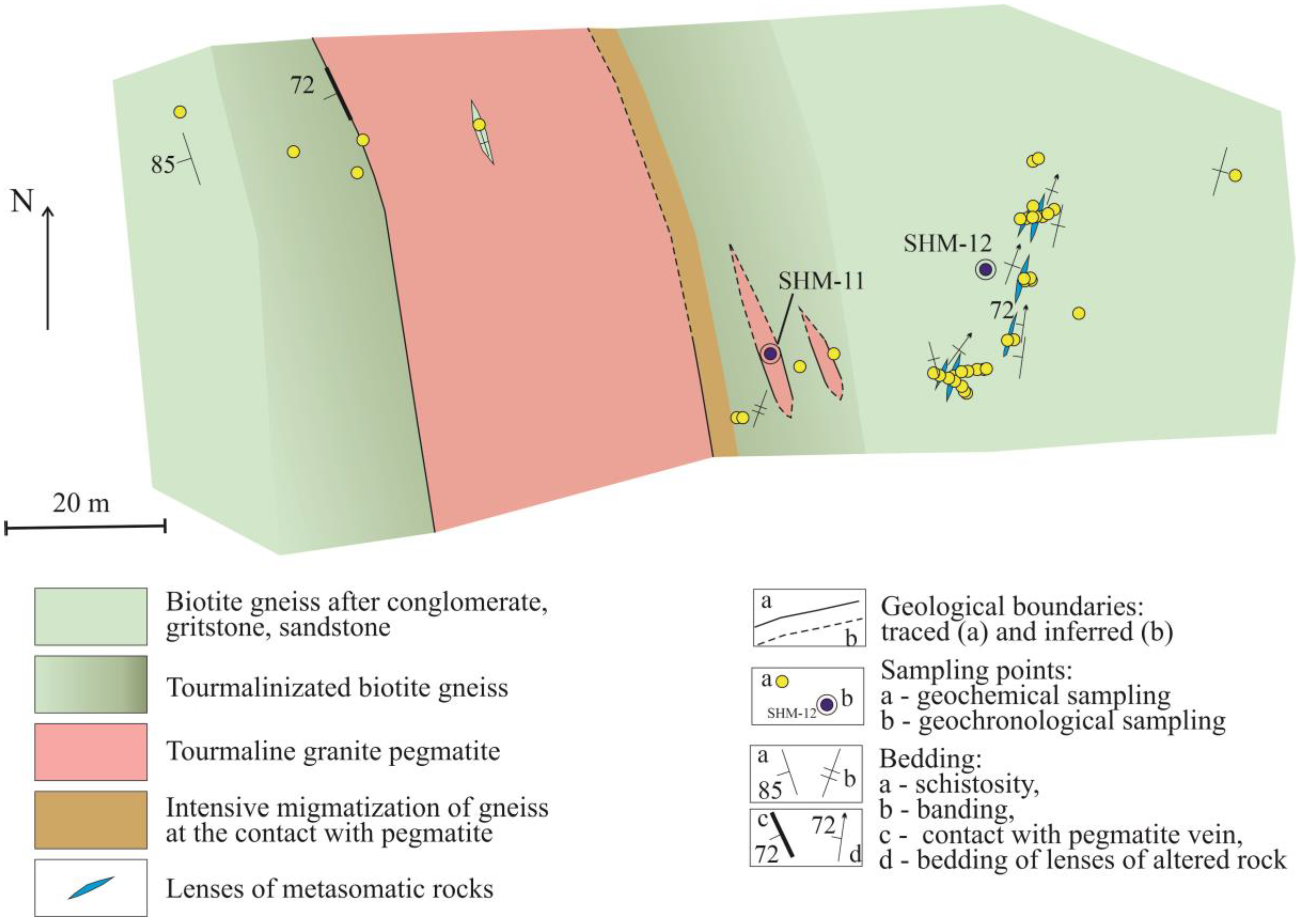
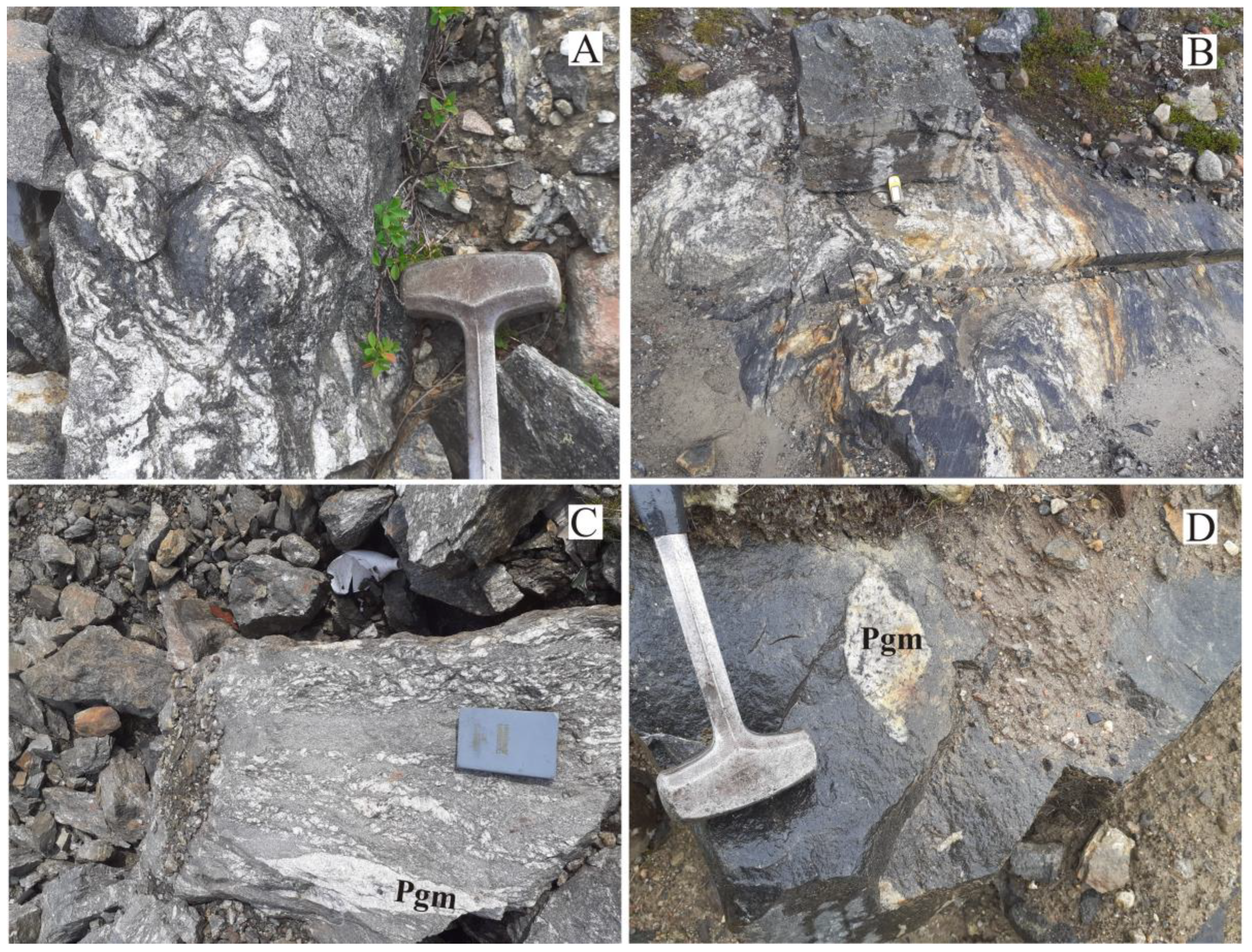
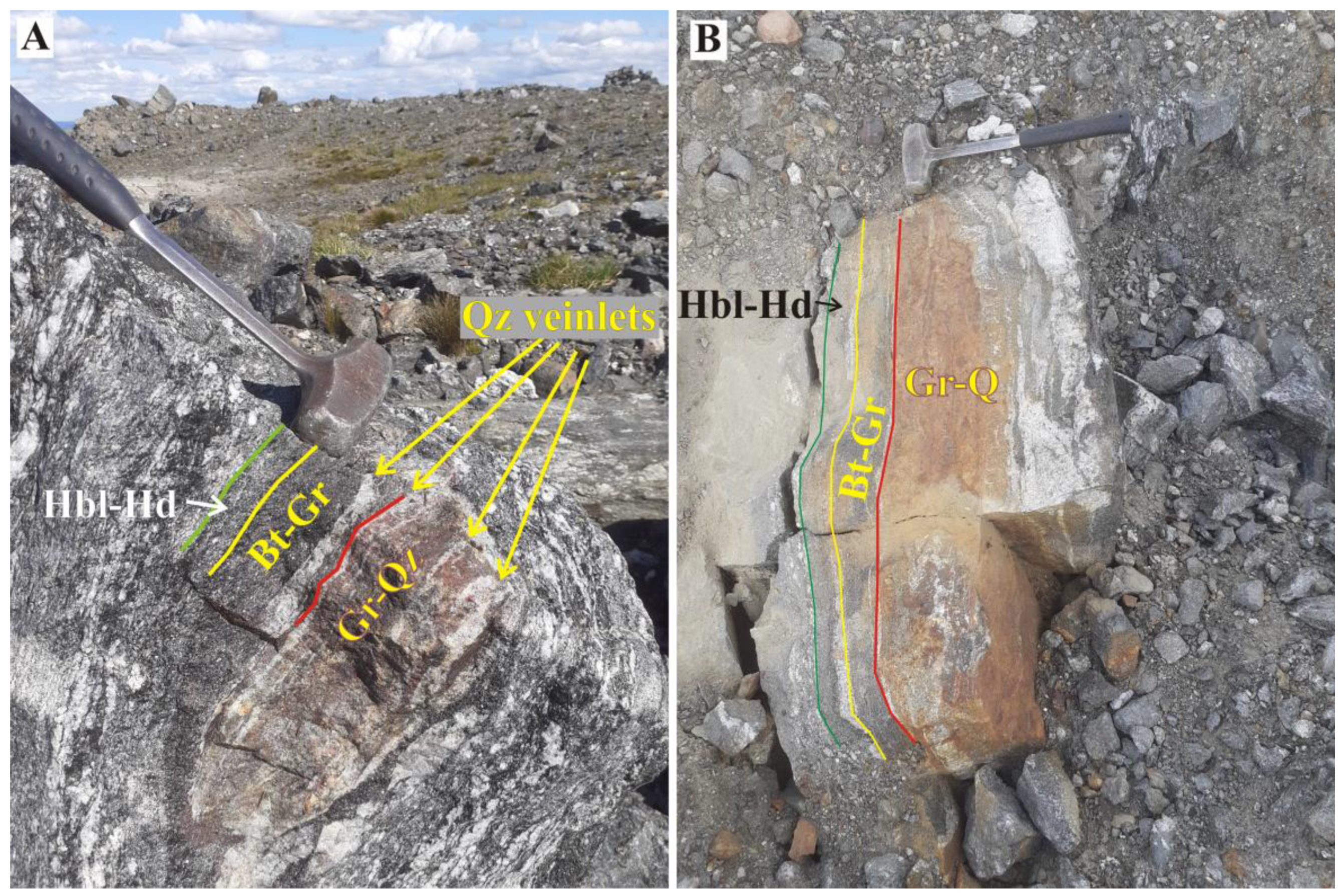



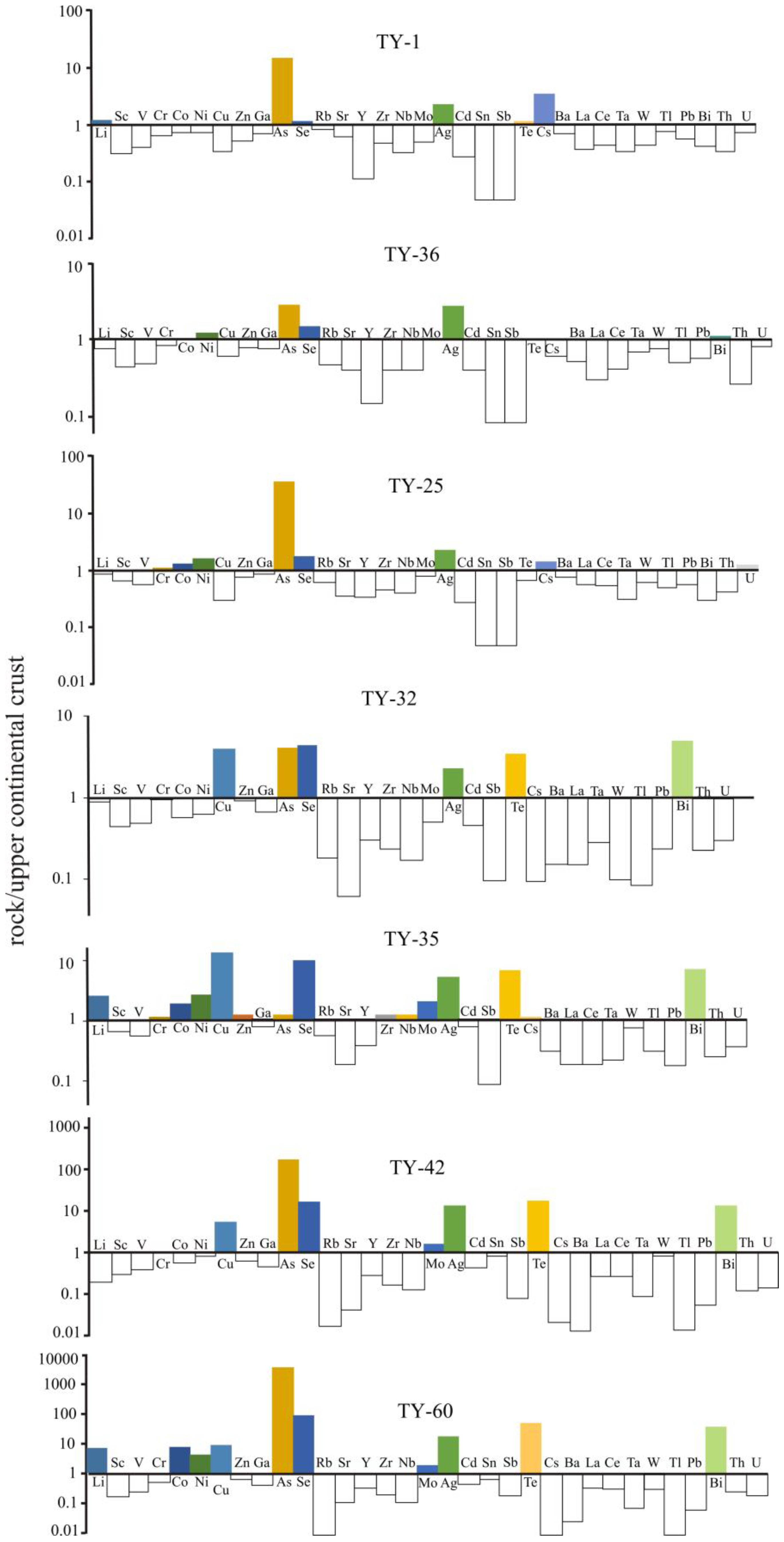
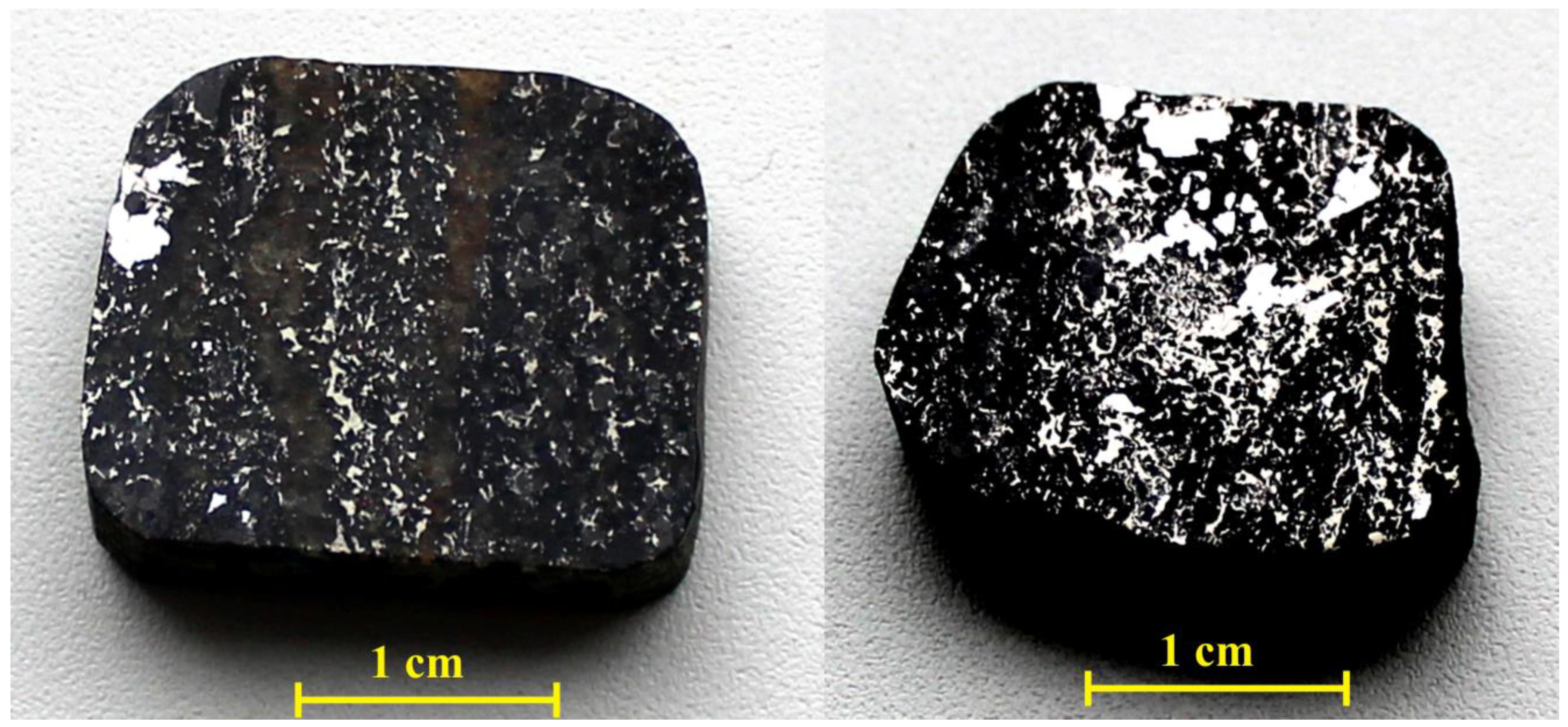
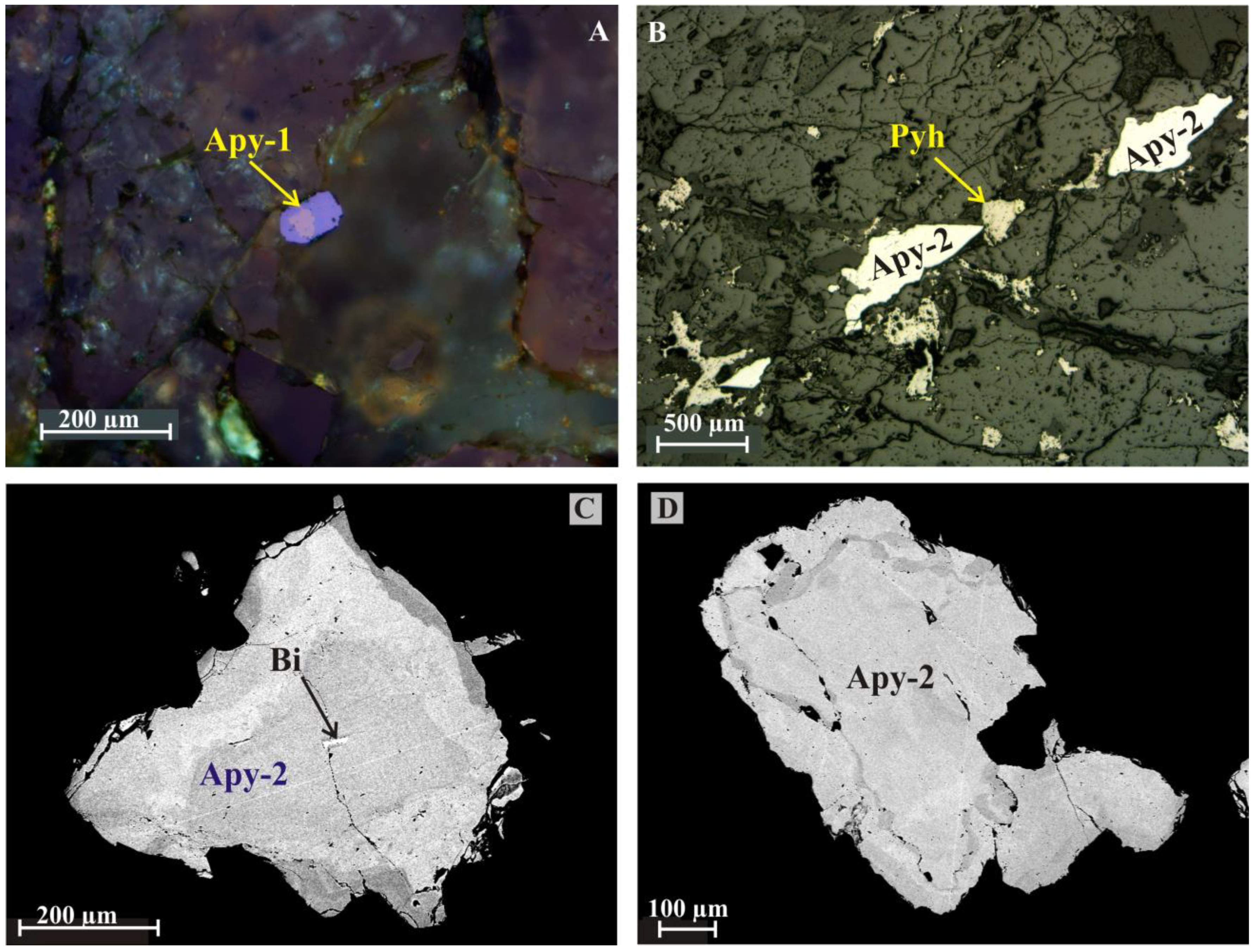


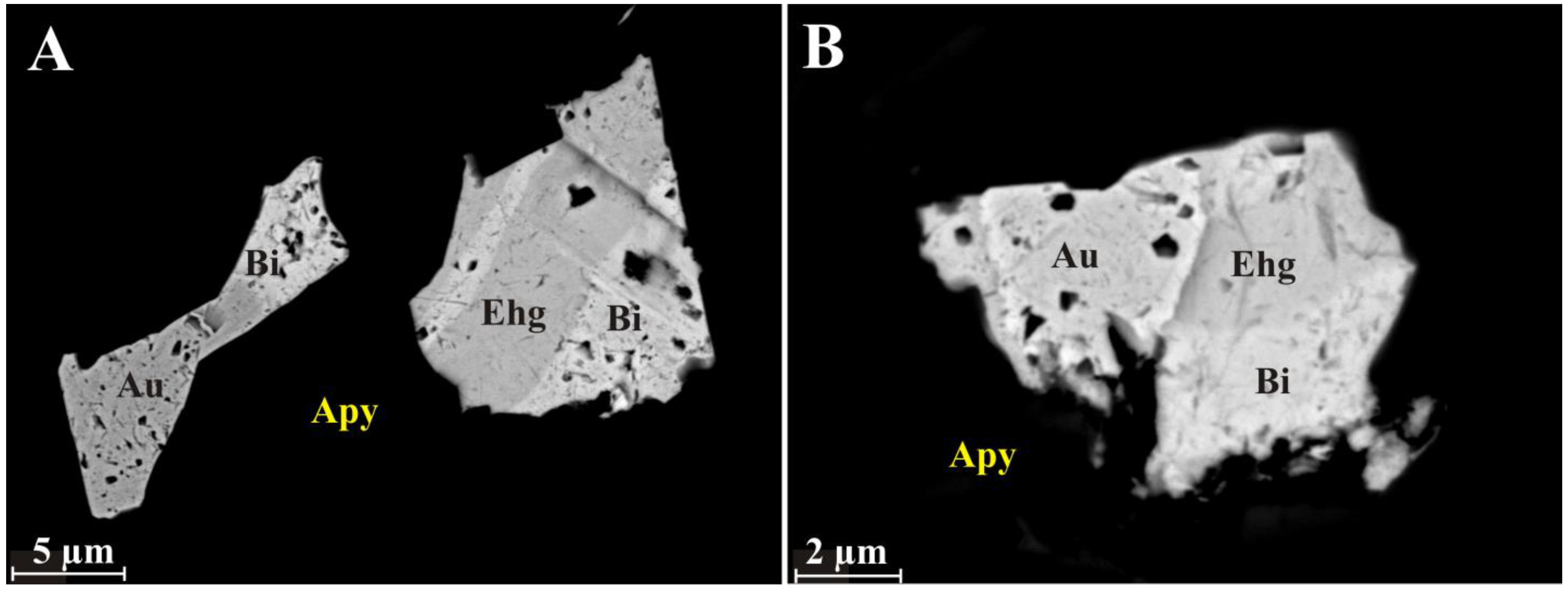
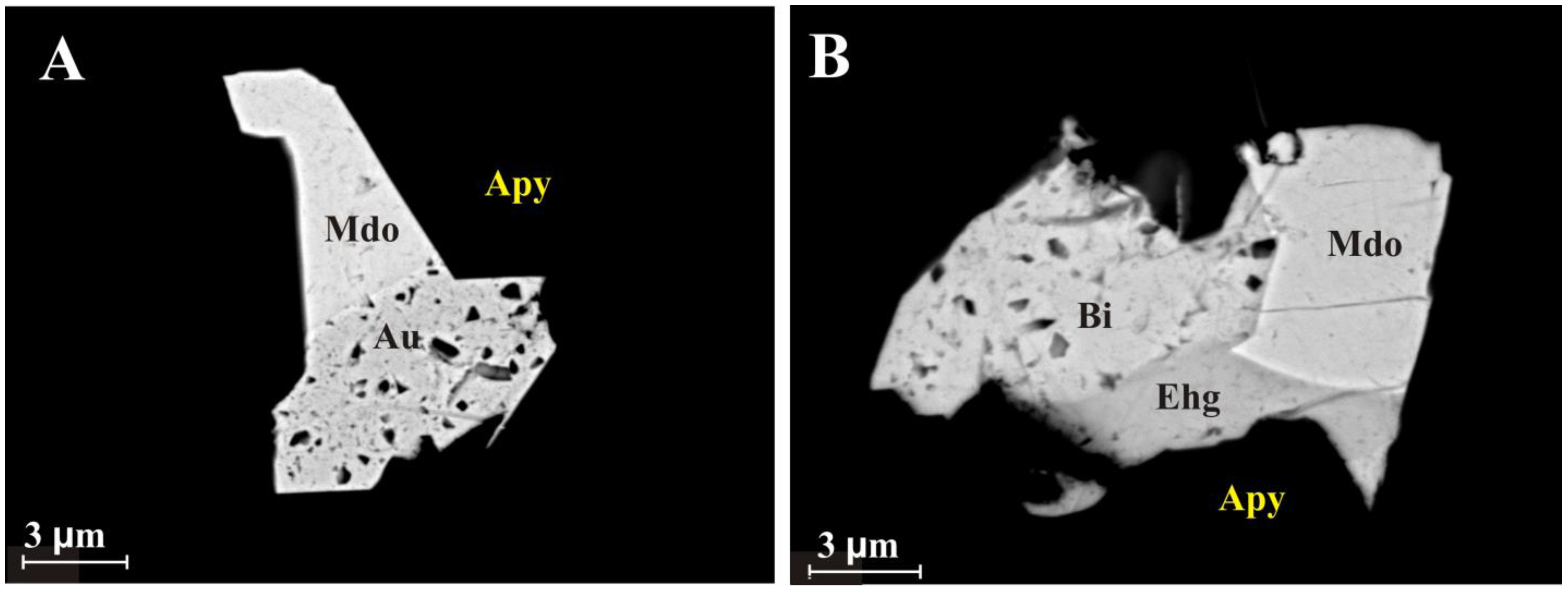
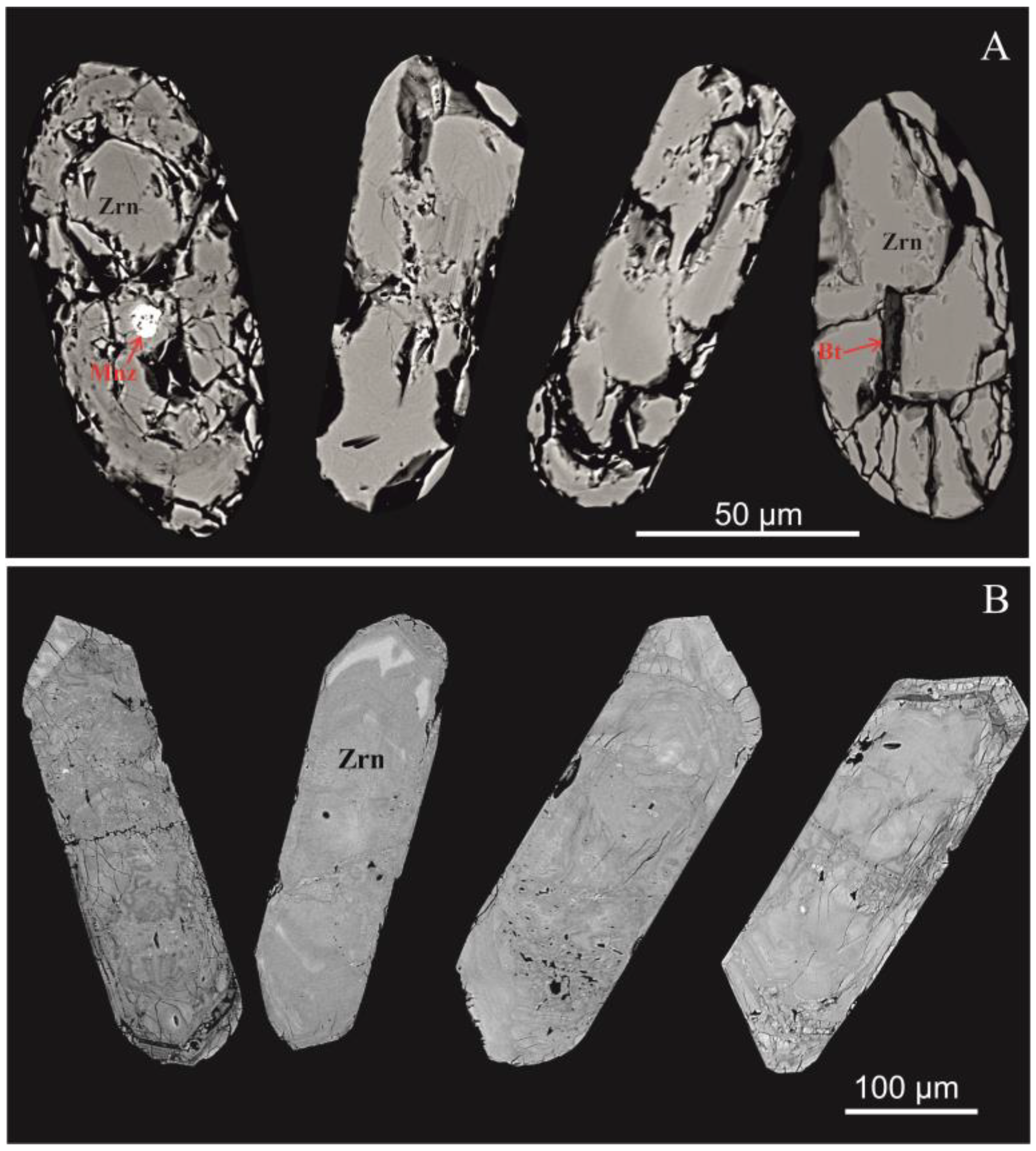
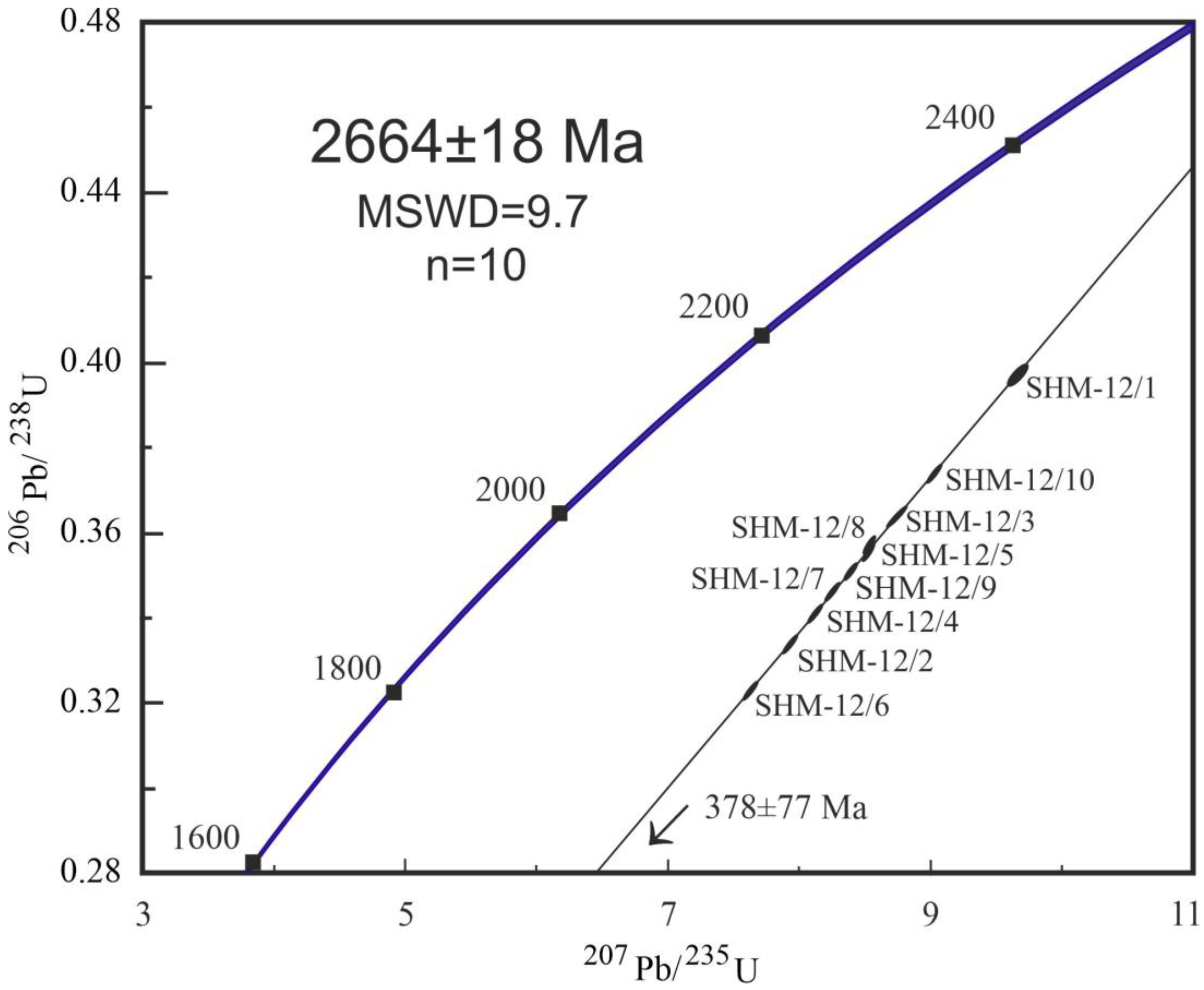

| Sample No. | TУ-25-1 | TУ-25-1 | TУ-25-2 | TУ-25-2 | TУ-31 | TУ-31 | TУ-41 | TУ-41 | TУ-45 | TУ-45 | TY-41-1 | TY-41-1 | TY-41-2 | TY-41-2 | TY-29 | TY-42 | TY-42 | TY-41 | TY-41 | TY-29 | TY-42 | TY-42 |
|---|---|---|---|---|---|---|---|---|---|---|---|---|---|---|---|---|---|---|---|---|---|---|
| Mineral | Apy-1-C | Apy-1-R | Apy-1-C | Apy-1-R | Apy-1-C | Apy-1-R | Apy-1-C | Apy-1-R | Apy-1-C | Apy-1-R | Apy-2-C | Apy-2-R | Apy-2-C | Apy-2-R | Apy-2 | Apy-2 | Apy-2 | Lo | Lo | Lo | Lo | Lo |
| S | 14.94 | 18.32 | 16.08 | 18.94 | 15.49 | 18.36 | 18.16 | 20.03 | 17.93 | 19.28 | 18.66 | 19.30 | 17.77 | 19.28 | 17.37 | 18.06 | 18.21 | 1.40 | 1.98 | 1.84 | 1.83 | 2.04 |
| Fe | 26.46 | 31.4 | 27.92 | 30.56 | 27.73 | 31.49 | 33.15 | 34.61 | 31.89 | 33.65 | 33.25 | 34.54 | 33.43 | 34.36 | 33.78 | 33.62 | 33.63 | 27.66 | 28.23 | 28.03 | 25.11 | 26.31 |
| Co | 3.76 | 2.32 | 3.12 | 2.44 | 4.11 | 2.23 | 0.47 | 0.13 | 1.28 | 0.48 | 0.34 | 0.12 | 0.39 | 0.09 | 0.07 | 0.24 | 0.17 | 0.08 | 0.13 | 0.10 | 0.49 | 0.42 |
| Ni | 2.89 | 0.64 | 2.25 | 0.81 | 1.62 | 0.38 | 0.24 | bdl | 0.29 | 0.02 | 0.49 | bdl | 0.38 | bdl | 0.17 | 0.26 | 0.11 | 0.09 | 0.10 | 0.13 | 2.07 | 0.68 |
| As | 51.83 | 47.69 | 50.57 | 47.45 | 50.93 | 46.8 | 47.86 | 45.47 | 48.52 | 46.38 | 47.96 | 46.72 | 48.59 | 45.80 | 48.80 | 47.87 | 48.09 | 70.27 | 69.35 | 69.94 | 70.26 | 70.04 |
| Total | 99.88 | 100.37 | 99.93 | 100.2 | 99.88 | 99.26 | 99.88 | 100.25 | 99.91 | 99.81 | 100.70 | 100.67 | 100.55 | 99.53 | 100.19 | 100.05 | 100.21 | 99.51 | 99.79 | 100.04 | 99.76 | 99.49 |
| Atoms per formula unit | ||||||||||||||||||||||
| S | 0.805 | 0.946 | 0.852 | 0.965 | 0.831 | 0.957 | 0.94 | 1.014 | 0.927 | 0.986 | 0.952 | 0.982 | 0.921 | 0.992 | 0.908 | 0.937 | 0.939 | 0.089 | 0.125 | 0.116 | 0.114 | 0.127 |
| Fe | 0.819 | 0.931 | 0.850 | 0.894 | 0.854 | 0.942 | 0.985 | 1.006 | 0.946 | 0.987 | 0.975 | 1.009 | 0.996 | 1.015 | 1.014 | 1.001 | 0.996 | 1.009 | 1.024 | 1.013 | 0.904 | 0.944 |
| Co | 0.110 | 0.065 | 0.090 | 0.068 | 0.120 | 0.063 | 0.013 | 0.004 | 0.036 | 0.013 | 0.009 | 0.003 | 0.011 | 0.002 | 0.002 | 0.007 | 0.005 | 0.003 | 0.004 | 0.003 | 0.017 | 0.014 |
| Ni | 0.085 | 0.018 | 0.065 | 0.023 | 0.048 | 0.011 | 0.007 | 0.000 | 0.008 | 0.001 | 0.014 | 0.000 | 0.011 | 0.000 | 0.005 | 0.007 | 0.003 | 0.003 | 0.003 | 0.004 | 0.071 | 0.023 |
| As | 1.195 | 1.054 | 1.148 | 1.035 | 1.169 | 1.043 | 1.06 | 0.986 | 1.073 | 1.014 | 1.048 | 1.018 | 1.079 | 1.008 | 1.092 | 1.063 | 1.061 | 1.911 | 1.875 | 1.884 | 1.886 | 1.873 |
| at.% As | 39.7 | 35.0 | 38.2 | 34.7 | 38.7 | 34.6 | 35.3 | 32.7 | 35.9 | 33.8 | 34.9 | 33.8 | 35.7 | 33.4 | 36.1 | 35.2 | 35.3 | 63.4 | 61.8 | 62.4 | 63.0 | 62.8 |
| Mineral | Ehg | Ehg | Ehg | Ehg | Ehg | Ehg | Ehg | Hdl | Hdl | Mdo | Mdo | Bi | Bi | Bi |
|---|---|---|---|---|---|---|---|---|---|---|---|---|---|---|
| S | bdl | bdl | bdl | bdl | bdl | bdl | bdl | bdl | bdl | bdl | bdl | 0.06 | bdl | bdl |
| Fe | 0.27 | bdl | bdl | 0.45 | 0.27 | 0.96 | 1.33 | bdl | bdl | bdl | 2.89 | 0.27 | 0.27 | 1.37 |
| As | 0.08 | bdl | bdl | 0.00 | 0.03 | 0.10 | bdl | bdl | bdl | 0.12 | 0.13 | 0.05 | 0.14 | |
| Te | 18.61 | 18.68 | 18.34 | 16.38 | 18.29 | 18.36 | 18.25 | 23.45 | 24.93 | bdl | bdl | 0.00 | bdl | bdl |
| Au | bdl | bdl | bdl | bdl | bdl | bdl | bdl | bdl | bdl | 63.78 | 62.82 | bdl | bdl | bdl |
| Pb | bdl | 0.78 | bdl | bdl | bdl | 0.94 | bdl | 4.08 | bdl | bdl | bdl | bdl | bdl | bdl |
| Bi | 81.49 | 80.54 | 80.23 | 82.49 | 80.36 | 79.64 | 79.05 | 72.47 | 75.07 | 36.22 | 33.85 | 99.02 | 99.88 | 98.43 |
| Total | 100.45 | 100.00 | 98.56 | 99.39 | 98.95 | 99.89 | 98.73 | 100.00 | 100.00 | 100.00 | 99.68 | 99.49 | 100.20 | 99.94 |
| Atoms per formula unit | ||||||||||||||
| S | 0.047 | 0.004 | ||||||||||||
| Fe | 0.099 | 0.168 | 0.099 | 0.347 | 0.479 | 0.291 | 0.010 | 0.010 | 0.049 | |||||
| As | 0.022 | 0.008 | 0.028 | 0.009 | 0.004 | 0.001 | 0.004 | |||||||
| Te | 2.962 | 3.006 | 2.998 | 2.646 | 2.956 | 2.896 | 2.879 | 3.340 | 3.523 | 0.000 | ||||
| Au | 1.954 | 1.791 | ||||||||||||
| Pb | 0.077 | 0.091 | 0.358 | |||||||||||
| Bi | 7.917 | 7.915 | 8.003 | 8.140 | 7.934 | 7.667 | 7.615 | 6.302 | 6.477 | 1.046 | 0.910 | 0.982 | 0.989 | 0.947 |
| Fe | 1.94 | 0.48 | 1.48 | 1.12 | 1.71 | 0.77 | 0.24 | 1.11 | 0.11 | 0.24 | 1.35 | 1.67 |
| As | 0.04 | 0.01 | 0.04 | bdl | 0.03 | 0.07 | 0.10 | 0.11 | bdl | bdl | bdl | bdl |
| Ag | 7.34 | 21.22 | 35.73 | 45.78 | 3.78 | 4.78 | 29.71 | 8.78 | 18.17 | 18.68 | 6.23 | bdl |
| Au | 88.97 | 77.08 | 61.42 | 53.10 | 94.19 | 92.83 | 69.32 | 89.45 | 77.69 | 78.62 | 91.16 | 99.22 |
| Total | 98.29 | 98.80 | 98.67 | 100.00 | 99.71 | 98.46 | 99.37 | 99.45 | 95.98 | 97.53 | 98.75 | 100.89 |
| Atoms per formula unit | ||||||||||||
| Fe | 0.063 | 0.014 | 0.040 | 0.028 | 0.056 | 0.026 | 0.007 | 0.036 | 0.003 | 0.007 | 0.044 | 0.056 |
| As | 0.001 | 0.000 | 0.001 | 0.001 | 0.002 | 0.002 | 0.003 | |||||
| Ag | 0.123 | 0.330 | 0.494 | 0.594 | 0.064 | 0.084 | 0.435 | 0.146 | 0.298 | 0.300 | 0.106 | |
| Au | 0.814 | 0.656 | 0.465 | 0.378 | 0.879 | 0.889 | 0.556 | 0.816 | 0.698 | 0.692 | 0.850 | 0.944 |
| Sample No./ Fraction No. | Weight, mg/ Size, μm | Pb, ppm | U, ppm | Isotope Ratios | Rho | Age, Ma | ||||||
|---|---|---|---|---|---|---|---|---|---|---|---|---|
| 206Pb/204Pb * | 207Pb/206Pb * | 208Pb/206Pb * | 206Pb/238U | 207Pb/235U | 206Pb/238U | 207Pb/235U | 207Pb/206Pb | |||||
| Sample SHM-12—biotite gneiss | ||||||||||||
| SHM-12/1 | 0.2/<100 | 165 | 358 | 533 | 0.1999 ± 0.0001 | 0.1281 ± 0.0002 | 0.3958 ± 0.0015 | 9.669 ± 0.038 | 0.91 | 2150 ± 9 | 2404 ± 10 | 2627 ± 3 |
| SHM-12/2 | 0.5/>100 | 130 | 341 | 702 | 0.1907 ± 0.0001 | 0.1246 ± 0.0002 | 0.3322 ± 0.0049 | 7.9400 ± 0.012 | 0.99 | 1849 ± 27 | 2224 ± 33 | 2590 ± 2 |
| SHM-12/3 | 0.5/>100 | 141 | 337 | 822 | 0.1891 ± 0.0001 | 0.1291 ± 0.0002 | 0.3639 ± 0.0011 | 8.7448 ± 0.026 | 0.96 | 2000 ± 6 | 2312 ± 7 | 2599 ± 2 |
| SHM-12/4 | 0.2/>50 | 164 | 363 | 485 | 0.1972 ± 0.0001 | 0.3042 ± 0.0001 | 0.3418 ± 0.0014 | 8.1055 ± 0.040 | 0.91 | 1896 ± 8 | 2243 ± 11 | 2577 ± 4 |
| SHM-12/5 | 0.5/<100 | 361 | 803 | 1178 | 0.1845 ± 0.0001 | 0.2709 ± 0.0001 | 0.3551 ± 0.0007 | 8.5313 ± 0.017 | 0.94 | 1959 ± 4 | 2289 ± 5 | 2599 ± 1 |
| SHM-12/6 | 0.3/<50 | 158 | 371 | 539 | 0.1909 ± 0.0001 | 0.2773 ± 0.0001 | 0.3226 ± 0.0016 | 7.6289 ± 0.038 | 0.96 | 1834 ± 9 | 2188 ± 11 | 2539 ± 3 |
| SHM-12/7 | 0.4/<50 | 186 | 432 | 818 | 0.1829 ± 0.0001 | 0.2064 ± 0.0001 | 0.3457 ± 0.0010 | 8.2387 ± 0.025 | 0.88 | 1962 ± 6 | 2258 ± 7 | 2538 ± 2 |
| SHM-12/8 | 0.4/<100 | 175 | 406 | 1242 | 0.1829 ± 0.0001 | 0.2062 ± 0.0001 | 0.3565 ± 0.0011 | 8.5121 ± 0.025 | 0.92 | 1966 ± 6 | 2287 ± 7 | 2588 ± 2 |
| SHM-12/9 | 0.3/<50 | 255 | 615 | 574 | 0.1942 ± 0.0001 | 0.1505 ± 0.0001 | 0.3502 ± 0.0017 | 8.3507 ± 0.0011 | 0.96 | 1935 ± 9 | 2270 ± 11 | 2586 ± 3 |
| SHM-12/10 | 0.5/<50 | 142 | 305 | 550 | 0.1968 ± 0.0001 | 0.2235 ± 0.0001 | 0.3723 ± 0.0016 | 8.9664 ± 0.0011 | 0.94 | 2040 ± 9 | 2335 ± 10 | 2603 ± 3 |
| Sample SHM-11—tourmaline granite pegmatite | ||||||||||||
| SHM-11/1 | 0.3/<200 | 1218 | 2587 | 1426 | 0.1724 ± 0.0001 | 0.03001 ± 0.0001 | 0.4633 ± 0.0005 | 10.509 ± 0.011 | 0.90 | 2463 ± 2 | 2481 ± 2 | 2495 ± 1 |
| SHM-11/2 | 0.9/<150 | 729 | 1534 | 1233 | 0.1741 ± 0.0001 | 0.05311 ± 0.0002 | 0.4449 ± 0.0007 | 10.068 ± 0.015 | 0.95 | 2373 ± 4 | 2441 ± 4 | 2499 ± 1 |
| SHM-11/3 | 0.6/>100 | 793 | 1619 | 1723 | 0.1719 ± 0.0001 | 0.02737 ± 0.0001 | 0.4715 ± 0.0011 | 10.714 ± 0.026 | 0.99 | 2490 ± 6 | 2499 ± 6 | 2506 ± 1 |
| SHM-11/4 | 1.7/>250 | 1109 | 2370 | 2347 | 0.1695 ± 0.0001 | 0.02410 ± 0.0001 | 0.4529 ± 0.0009 | 10.265 ± 0.021 | 0.96 | 2408 ± 5 | 2459 ± 5 | 2501 ± 1 |
| SHM-11/5 | 1.2/>200 | 1140 | 2643 | 2091 | 0.1686 ± 0.0001 | 0.02238 ± 0.0001 | 0.4182 ± 0.0009 | 9.3869 ± 0.017 | 0.94 | 2252 ± 5 | 2377 ± 5 | 2485 ± 1 |
Disclaimer/Publisher’s Note: The statements, opinions and data contained in all publications are solely those of the individual author(s) and contributor(s) and not of MDPI and/or the editor(s). MDPI and/or the editor(s) disclaim responsibility for any injury to people or property resulting from any ideas, methods, instructions or products referred to in the content. |
© 2024 by the authors. Licensee MDPI, Basel, Switzerland. This article is an open access article distributed under the terms and conditions of the Creative Commons Attribution (CC BY) license (https://creativecommons.org/licenses/by/4.0/).
Share and Cite
Kalinin, A.A.; Kudryashov, N.M.; Savchenko, Y.E. Timing and Evolution of Gold Mineralization in the Maljavr Occurrence (NW Russia), NE Part of the Fennoscandian Shield. Minerals 2024, 14, 535. https://doi.org/10.3390/min14060535
Kalinin AA, Kudryashov NM, Savchenko YE. Timing and Evolution of Gold Mineralization in the Maljavr Occurrence (NW Russia), NE Part of the Fennoscandian Shield. Minerals. 2024; 14(6):535. https://doi.org/10.3390/min14060535
Chicago/Turabian StyleKalinin, Arkadii A., Nickolay M. Kudryashov, and Yevgeny E. Savchenko. 2024. "Timing and Evolution of Gold Mineralization in the Maljavr Occurrence (NW Russia), NE Part of the Fennoscandian Shield" Minerals 14, no. 6: 535. https://doi.org/10.3390/min14060535
APA StyleKalinin, A. A., Kudryashov, N. M., & Savchenko, Y. E. (2024). Timing and Evolution of Gold Mineralization in the Maljavr Occurrence (NW Russia), NE Part of the Fennoscandian Shield. Minerals, 14(6), 535. https://doi.org/10.3390/min14060535








